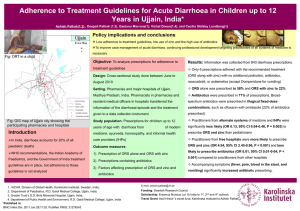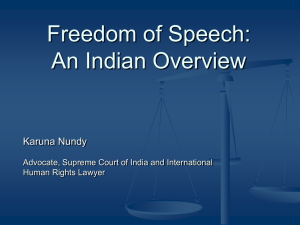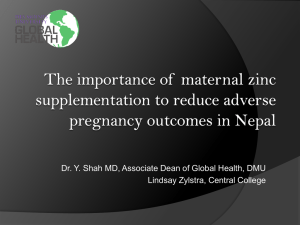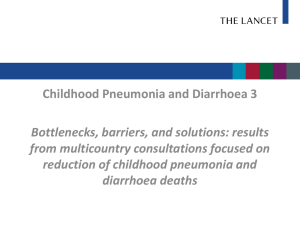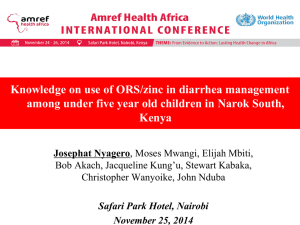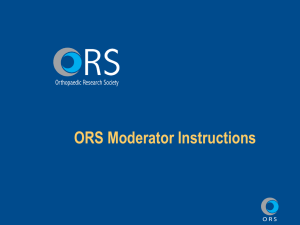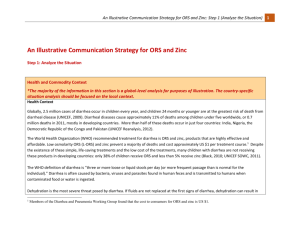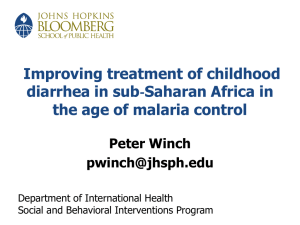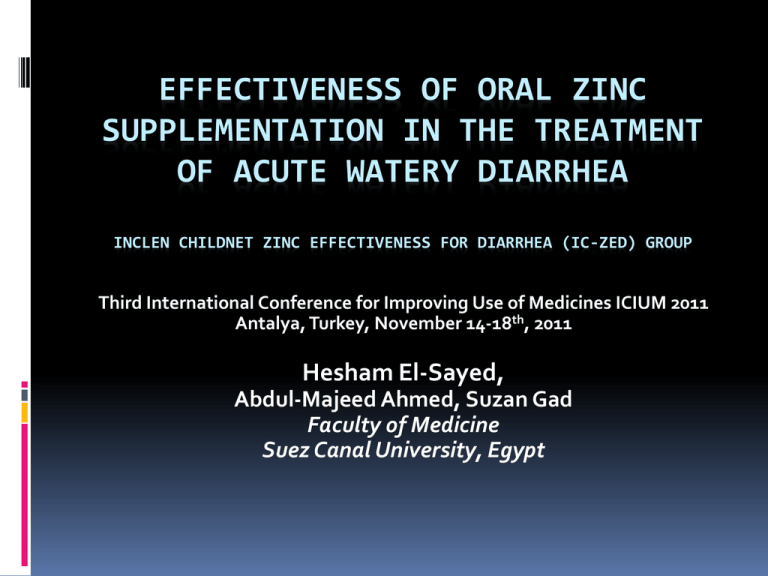
EFFECTIVENESS OF ORAL ZINC
SUPPLEMENTATION IN THE TREATMENT
OF ACUTE WATERY DIARRHEA
INCLEN CHILDNET ZINC EFFECTIVENESS FOR DIARRHEA (IC-ZED) GROUP
Third International Conference for Improving Use of Medicines ICIUM 2011
Antalya, Turkey, November 14-18th, 2011
Hesham El-Sayed,
Abdul-Majeed Ahmed, Suzan Gad
Faculty of Medicine
Suez Canal University, Egypt
Study Rationale & Problem statement
Oral rehydration solution (ORS) has been
successfully used around the world, and has been
responsible for reduction of diarrheal deaths in
the last 2 decades
In spite of the success of ORS in prevention of
dehydration, there is demand for medicines that
can reduce the duration and severity of diarrhea
Zinc has been shown to be efficacious in reducing
duration of diarrhea and associated mortality
Study Objectives
To determine the effectiveness of oral zinc
supplementation in the treatment of acute
watery diarrhea.
To assess adherence to zinc therapy
To evaluate the impact of zinc therapy on
the duration of diarrheal episodes, the use
of ORS, and the usage of antibiotics and/or
“antidiarrheal” medicines
Study Area & Population
Ismailia governorate,
Egypt, with population
of one million
inhabitants
Four primary health care
centers
Children presenting to
the outpatient clinics of
participating centers
Other study sites:
(Brazil, Ethiopia, India & Philippines)
4
Ismailia
Inclusion Criteria
1. Children aged 2 to 59 months.
2. Patients resenting to the study centers with
diarrhea, defined as three or more loose or
watery motions per day, and of less than 7
days duration
3. Patients who are able to drink and do not have
persistent vomiting
4. Informed consent by a legal guardian
5
Exclusion Criteria
Severe malnutrition (weight for height z score [WHZ] -3 SD)
Patients on IMCI-WHO Plan B or C management
of dehydration
Patient suffering from dysentery
Currently using antimicrobial drugs or having
other conditions requiring antimicrobials
Mothers reported positive for HIV
Not residing in catchment area
Study Design
Randomized, controlled
effectiveness trial
7
Study Maneuver
Block randomization procedure was used using block of
size 8
Recruited patients received either zinc and ORS or ORS
alone
Both groups received instructions for the use of ORS,
those randomized to the zinc group also received zinc
tablets along with culturally appropriate message for
zinc usage
Zinc (Nutriset; manufactured by Rodael, Malaunay, France) as well as
ORS was provided by WHO
Zinc was supplemented as dispersible 10-mg tablets,
mothers given instructions for dissolving it in water or
breast milk, and administered for 14 days
Design of the Zinc Logo
Each tablet contains:
10 mg Zinc Sulphate.
The tablet should be dissolved
in tablespoon of water.
:يحتوى كل قرص على
ملجم سلفات الزنك10
يذاب القرص فى ملعقة مائدة من الماء
أولبن األم
منظمة الصحة العالمية
HYDROZINC
هيدروزنك
Patient Assessment and Follow-Up
Baseline characteristics were recorded for eligible
children
All caretakers were trained to recognize the signs of
worsening illness, as outlined in the WHO diarrhea
manual, and advised to report to the hospital
immediately if any of these signs developed
Caregivers were asked to come for two follow-up visits,
the first between days 3 and 5 and the second between
days 15 and 17, bringing with them any unused ORS
packets and zinc tablets
A project nurse visited the homes of the patients if the
child was not brought to the hospital on the expected
day for follow-up visits
Outcome Measures
ORS use on first follow-up visit in last 24 hours
Adherence to zinc tablets (consumption of
greater than 80% of the doses)
Use of antimicrobial / antidiarrheal drugs
Duration of diarrheal episodes
Frequencies of adverse effects of zinc therapy
Treatment failures, defined as one or more of
the following after institution of therapy:
dehydration, need for intravenous fluids,
hospitalization, death
STUDY RESULTS
Study Participants
412 children aged 2-59 months were
enrolled in the study; 219 males (53.2%)
and 193 females (46.8%)
Mean age of the recruited children was
17.0 + 12.6 months
222 children received zinc+ORS therapy
and 190 were controls and received ORS
alone; 11 lost to follow up by day 15
(8 Zinc+ORS & 3 ORS)
Study Groups & Sex Distribution of the
Recruited Egyptian Children
Baseline Characteristics of
Recruited Children
Characteristic
Number
412
Age (mo). mean. SD
17.0, 12.6
Sex, Female (%)
46.8
Weight for height , 2 to -3 SD, %
0.7
Duration of Illness, mean, SD
1.2, 0.6
Vomiting (%)
37
Breastfed Children [less 12 mo] (n/N %) 203/210, 97.0
Study Results
The study showed high adherence to zinc therapy,
as 73% of the children consumed more than 80% of
the zinc tablets
Zinc supplementation caused significant reduction
in the duration of diarrheal episodes, of about
24%, in the zinc-treated group
Significant reduction in the use of antidiarrheals
and/or antibiotics use rate in the zinc study group
compared to controls (7.7% vs. 20.5%)
Frequency of ORS use during diarrheal episodes
was similar in the 2 study groups
Comparison of Clinical Outcome of
Zinc+ORS Vs ORS group
ORS Use at Day 3
Duration of Diarrheal
Episode (Mean+SD)
Antimicrobials/Antidiarrheals
Drug Use in Day 15
Adverse Effects
(Vomiting)
Failure of Therapy
* P ˂0.05
Zinc +ORS
N, (%)
35 (100.0)
ORS
N, (%)
62 (98.4)
3.53+1.38
4.75+1.06*
17 (7.7)
39 (20.5) *
26 (11.7)
11 (5.8) *
0
1 (0.5)
Conclusions
Oral zinc supplementation, in under-5 children
suffering from acute watery diarrhea, is
efficacious in reducing the duration of diarrheal
episodes and in reducing the maluse of
“antidiarrheals” and antibiotics, with no decrease
in the frequency of ORS use.
Children showed good adherence & acceptance
to zinc therapy without considerable side effects
Acknowledgement
The study was supported by grant from
USAID-CHR, Washington
(via INCLEN Trust)
Johns Hopkins University
& WHO Technical support
19


